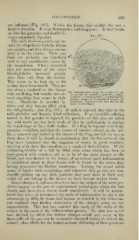Page 685 - My FlipBook
P. 685
INFLAMMATION. 695
are inflamed (Fig. 387). Within the tissues this exudate has but a
limited duration. It soon disintegrates and disappears. It first breaks
up into fine granules, and finally be-
comes completely liquefied.
The ivhite blood-covpusdes are ex-
uded (by diapedesis) with the fibrin-
ous exudate, and they always accom-
pany it in the tissues. Their mo-
tions are probably not interfered ^—
with to any considerable extent by
the coagulation. I have remarked
that the movements of the white
blood-globules increased greatly
after their exit from the vessels.
This seems to be kept up so far
as they have been traced. They are
uot alwavs confined to the tissues
ii . i* • 1 J. 1 • J. 1 Iris inflamed after injury by a piece of iron
that are living, but wander into al- thrust into the eyebalho, pigment; fi.circu-
lar tibres; c, radiating fibres ;(/, inflammatory
mObt anyining mat comes in tlipir
mn^t nnvfliino- tlmf pnmpc in tneir
exudate composed of coagulated lymph and
WaV. Blood-clot is invaded by leucocytes. Leucocytes are seen also in the
• tissue (X 350, Black).
, , , , _oii 1 -^1
them, and tliey become filled with
the red globules. (See Fig. 387.) If milk is injected, they take up the
milk-globules and become filled with them. If an insoluble coloring
matter, in fine powder be injected, the particles of this also are taken
up ; and much use has been made of this by pathologists in tracing
the wanderings of the.se little bodies. If a frog be injected wuth finely
granular vermilion, and then the cornea of another animal, as the rab-
bit, is removed and buried in the tissues of the frog, and left for tAvo or
three days, it will be found on examination that the leucocytes of the
frog have wandered into the fragment of cornea in great numbers,
carrying with them the vermilion as a mark of their identity. If the
swimming-bladder of a fish be filled with water which has been so
impregnated with common salt as to be of the same density as the
blood, and then buried in the tissues of an animal until inflammation
is established about it, these bodies will be found in the water, they
having penetrated the bladder membrane. Nothing but actual solids
seems to hinder their wanderings, and wherever they go they are con-
tinually picking up any little particles they may meet in their way
which do not belong in the tissues or have become useless there.
Tissue-changes in infamniation have been the subject of the most per-
sistent inquiry on the part of experimental pathologists within the last
decade, and have given rise to much controversy. It will be remem-
bered that when we terminated the study of inflammation by aid of the
microscope (p. 692) the tissue had become so clouded by the inflamma-
tory exudates that further observation of the changes going on was
impracticable. This fact has confined this mode of the study of the
subject to the onset of the inflammatory process. No plan has as yet
been devised by which the further changes which may occur in the
tissue-cells of the part can be accurately observed during the life of the
animal ; thus efforts for the further accurate following of these processes


